
Myouan Eisai (Myōan Eisai, 明菴栄西) is best known for bringing the Rinzai school of Zen Buddhism to Japan.
He also played a prominent role in Japanese tea history because he wrote the Kissayojoki (喫茶養生記), a book about tea.
A closer look at Eisai’s life
He was born on April 20th of 1141 in what is now Okayama prefecture. His father was a Shinto priest.
At the age of eleven he studied the Tendai school of Buddhism in Anyouji temple. When he was 14 he became ordained at Mount Hiei, near Kyoto.
As a side note, the Tendai school was founded by Saichō, another Buddhist monk. He was one of the first to bring tea seeds to Japan, according to written accounts.
When Eisai was 28 (year 1168), he traveled to Mount Tiantai (Tendai in Japanese) in China to further his studies. Since this was where his school of Buddhism originated, it was the best place to go.
In his six month’s stay, he learned that Zen teachings had become widespread in Chinese Buddhism. He also obtained 60 volumes of scriptures and offered them to the head priest of his school.
This was no small feat for such a young man, and so this gives us an impression of Eisai’s skill.
His second trip to China wouldn’t happen until 1187, when he was 47 years old. He wanted to visit India, the motherland of Buddha.
However, once in China the local government didn’t give him permission to cross the border, so he decided to study there once more.
Eisai spent four years as a disciple of Xuan Huaichang (虚庵懷敞), who was a master of the Rinzai school of Zen Buddhism.
He received the certification of Zen teacher (the first one given to a Japanese monk in China), and returned to Japan in 1191.
Eisai and tea
Eisai didn’t only bring the teachings of Rinzai Zen to Japan. He also brought tea seeds with him.
He first planted tea seeds in Mount Sefuri, on the border of Fukuoka and Saga prefectures. He thought that this place looked similar to Mount Tiantai, so it was a suitable place for the tea plants to grow.
In addition, he gave tea seeds to Myoue Shounin (明恵上人), a monk from Kousanji temple (高山寺) in Toganoo (栂尾), Kyoto. Myoue planted the seeds near the temple, and this was the beginning of tea in the region of Uji.
There’s a written account from 1214 where Shogun Minamoto was suffering from a hangover, and Eisai gave him tea and also his book: Kissayojoki. By then, Eisai was 74 years old.
The book talked about the health benefits of tea, how to cultivate it, and how to prepare it, among other things.
This led to the reintroduction of tea culture in Japan, because this time the lower classes began to drink it. Until then, tea was reserved for nobles and monks only.
Eisai died close to a year later and was buried in Kenninji, the temple that he founded back in 1202. He is now known as the father of Japanese tea culture.
